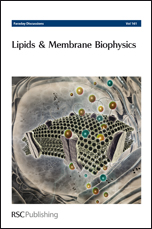Pulmonary surfactant is a lipid–protein complex essential to stabilize alveoli, by forming surface active films able to reach and sustain very low surface tensions (<2 mN m−1) during the film compression that occurs at end-expiration. The particular lipid composition of surfactant, including a high proportion of dipalmitoylphosphatidylcholine (DPPC), induces segregation of fluid ordered and disordered phases in surfactant membranes and films at physiological temperatures. The segregation of DPPC-enriched ordered phase has been related with the ability of surfactant films to produce very low tensions, while the presence in surfactant of two specific hydrophobic polypeptides, SP-B and SP-C, is absolutely required to facilitate surfactant dynamics, including film formation and re-spreading during expansion at inspiration. In the present study, we have used X-ray scattering to analyze the structure of (1) whole native surfactant membranes purified from porcine lungs, (2) membranes reconstituted from the organic extract of surfactant containing the full lipid complement and the physiological proportion of SP-B and SP-C, and (3) membranes reconstituted from the lipid fraction of surfactant depleted of proteins. Small angle X-ray scattering data from whole surfactant or from membranes reconstituted from surfactant organic extract indicated the co-existence of two lamellar phases with different thicknesses. Such phase coexistence disappeared upon heating of the samples at temperatures above physiological values. When assessed in a captive bubble surfactometer, which mimics interfacial compression–expansion dynamics, the ability of surfactant films to produce very low tensions is only maintained at temperatures permitting the coexistence of the two lamellar phases. On the other hand, membranes reconstituted in the absence of proteins produced diffractograms indicative of the existence of a single dominant lamellar phase at all temperatures. These data suggest that SP-B and SP-C establish membrane–membrane interactions coupling the stacks of different segregated phases. The low compressibility of surfactant films that leads to the maximal pressures (minimal tensions) is supported on one hand by the highly packed solid-like character of segregated DPPC-enriched domains and, on the other hand, by a high cohesivity of multilayered structures promoted by hydrophobic surfactant proteins, in particular SP-B, at the more dynamic disordered membrane regions, in which SP-B selectively partitions. Cryo-electron microscopy has shown that SP-B induces formation of tight membrane–membrane contacts, a finding that supports our inference concerning the role of these surfactant proteins.

 Please wait while we load your content...
Please wait while we load your content...